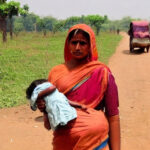Wombless Villages: In Maha, Poor Women Opting For Hysterectomies To Survive

Amid the ongoing climate crisis, women paying the cost of the climate crisis with their wombs, the report says
In a dramatic development, a recent report has revealed that several female sugarcane workers in Maharashtra are opting to undergo unnecessary hysterectomies to avoid absence from work and lose pay. The research conducted by the International Institute for Environment and Development (IIED) showed that drought is pushing poor women into exploitative sugarcane work.
In Maharastra’s Beed district, women are being forced to leave their homes to work in the sugar cane industry elsewhere because climate change is increasing the frequency of droughts and decimating their crops, according to the new paper from IIED.
The report revealed that many female labourers suffer debilitating menstrual periods due to the demanding nature of this work, which entails shifts up to 16 hours long. Exploitative informal contracts incorporate financial penalties for missing work, causing women to feel they have no choice but to have their wombs removed so their periods don’t prevent them from working.
“Hysterectomies of this kind are still taking place despite widespread outcry in India. The procedure, performed mostly in private clinics, can leave women with lasting pain and mental health problems,” it mentioned.
“Women paying the cost of the climate crisis with their wombs,” the report stated.
Notably, researchers surveyed 423 households in two different areas of Beed. People in 253 households migrated to work in the sugar industry, while people in the remaining 160 households did not travel to find work.
The most common reason given for migrating was drought and more than half the women from households that migrated (55.73 per cent ) had undergone a hysterectomy, compared to less than a fifth from households that had stayed in Beed (17.06 per cent ). According to reports, some were still in their twenties when they underwent the procedure.
Ritu Bharadwaj, Principal Researcher, IIED said, “When we talk about the losses incurred and the damage done by climate change, we’re not just talking about flooded apartments in New York, or scorched hillsides in Greece. These women’s experiences are also a result of climate change which has decimated their livelihoods, and some of what they have lost – their dignity, good health, in some cases their lives – is difficult to quantify.”
COP28 To Help?
Bharadwaj added that those in charge of the loss and damage fund agreed at COP28 last year should work with Indian officials to create a social support structure for labourers, to prevent more pain and heartache in future.
Delegates at the recent COP28 climate negotiations in Dubai agreed on a new loss and damage fund to address the inequity in the impacts of climate change which are already being felt acutely by many people in the global South.
The paper suggested how money from the fund could be used while attempting to begin quantifying the cost of health problems suffered by people like those migrating from Beed to work in the sugar cane fields.
“The new loss and damage fund could be used to provide additional benefits through social protection programmes during times of climate crisis like drought or flood. It could be used to incorporate climate risk assessments and planning into social protection programmes,” the paper suggested.
It could fund training programs for local officials and the construction of durable roads and facilities that remain functional during disasters, thereby ensuring uninterrupted delivery of social protection services. And it could fund the development of resilient infrastructure, like water conservation, for longer-term drought-proofing.
The study further revealed that the frequency of rain deficits in Beed has doubled in the past decade, compelling more individuals to migrate in search of livelihoods due to crop failures, debt and insufficient awareness about welfare programs. Contractors in the sugar industry prefer hiring couples, with husbands engaged in cane cutting and wives tasked with cleaning and loading, earning minimal wages of about Rs 250 Indian (USD 3) per tonne of cane.
Analysis of data between 1986 and 2022 implies a long-term trend of declining rainfall in the region, with droughts becoming more frequent and more severe. Village records and IIED’s survey data suggest migrating for work has also become markedly more common in the last couple of decades.
Data And More Data
A research paper by the National Library of Science titled ‘Hysterectomy in India: Spatial and multilevel analysis’ stated that India’s hysterectomy prevalence varies between 1.7 per cent and 9.8 per cent and numerous are conducted in the early years of life.
The paper added that unnecessary hysterectomies are being conducted among rural and poor women owing to factors such as fear instigated by medical professionals, solution for menstrual problems and related taboos, failure of appropriate gynaecological care, practical difficulties in living with reproductive health problems, the belief that hysterectomy is the best treatment, inappropriate use of insurance and fading employment opportunities.
A study from Maharashtra revealed that the problem is much deep-rooted, as hysterectomies have become the norm in a district, where cane-cutting contractors are unwilling to hire menstruating women, leading to wombless villages.
The issue highlighted the fact that women are compelled to ‘earn and care for their families’; hence, they balance their medical options with social responsibility. The dire circumstances, coupled with the absence of proper facilities, drive many women to opt for hysterectomies at private clinics.
Despite the health risks associated with the procedure, including back pain, joint issues and mental health concerns, women often remain unaware of these consequences. Narendra Gupta, from the non-profit organization Prayas, noted that private hospitals prioritise profit over patients’ well-being, contributing to the surge in unnecessary hysterectomies.
Following media scrutiny and legal action, the district administration attempted to curb the practice in 2019 by requiring hospitals to seek permission before performing hysterectomies. However, this measure failed to address the root cause, leading women to seek medical procedures in adjacent districts. Meanwhile, IIED’s Bharadwaj stressed the importance of addressing underlying issues to combat the distressing trend effectively.






































































































































































































































































































































































































































































































































































































































































































































































































































































































































































































































































































































































